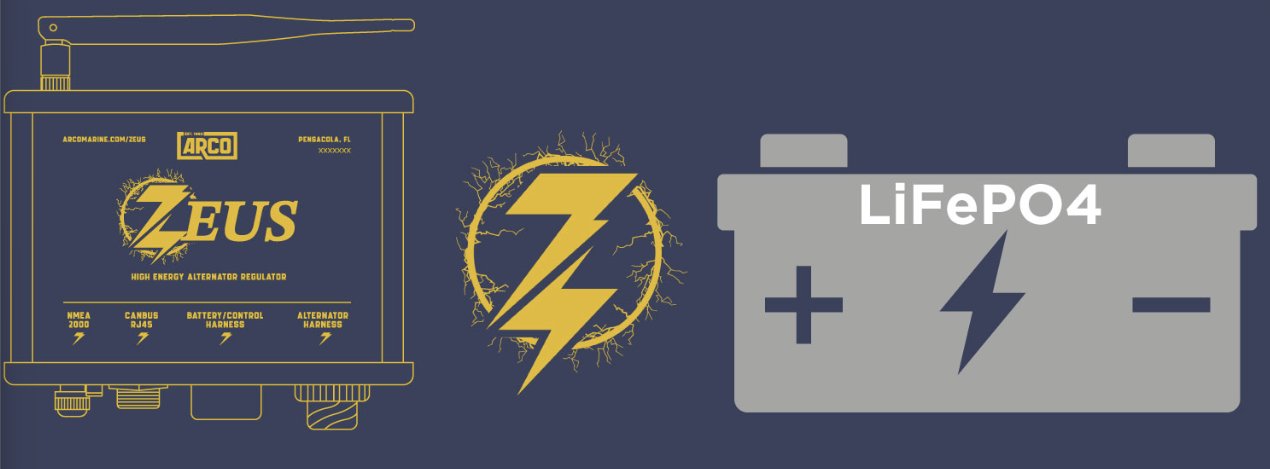
Why Your Standard Van Alternator Isn't Enough
Wanting to know if you really need an external alternator regulator for your boat, RV, or Van? Trying to understand the benefits of this technology vs simply using an internal regulator from your alternator?
External alternators are becoming dramatically more popular in the boating and RV space, and ARCO is leading the way with the new Zeus technology, a real game changer for boat and RV owners.
In this article, we’re going to make an honest analysis of the true benefits of an external alternator, and by the end, you’ll have a good sense as to whether or not this is the type of technology you’d like to consider with your boat or RV.
Sailboats, RVs, and vans are often equipped with small alternators that are designed to provide enough power to run essential electrical systems, such as the navigation lights, bilge pump, and VHF radio. However, these alternators can often be overwhelmed by the demands of running other electrical devices, such as a refrigerator, air conditioner, or toaster. This can lead to the alternator sending too much power to the batteries, which can shorten their lifespan and damage sensitive electronics.
If you are not using an external alternator regulator for your vehicle, then you will be dependent on the internal regulator within your alternator. These internal regulators have only one voltage setting. This one voltage setting can be problematic when paired with batteries due to different battery chemistries having different voltage settings.
External alternator regulators can help to prevent these problems by tailoring your charging voltage to your specific chemistry. External regulators also offer a number of other advantages over internal regulators, including:
#1 All lead acid batteries (not just lithium) require temperature compensated charging. Internally regulated alternators do not have this feature.
These batteries require a specific charging voltage to maintain their health and longevity. The charging voltage required for a lead acid battery varies depending on the temperature of the battery. At low temperatures, the charging voltage needs to be higher in order to ensure that the battery is fully charged. At high temperatures, the charging voltage needs to be lower to prevent the battery from overheating. If you are not using an external alternator regulator, you will be dependent on the internal regulator within your alternator. Internal regulators only have 1 voltage setting.
Internally regulated alternators have a built-in voltage regulator that maintains a constant charging voltage. However, the voltage regulator in an internally regulated alternator does not compensate for temperature change due to its one voltage setting. This means that if the battery temperature is low, the alternator will continue to charge the battery at the same voltage, which can lead to overcharging and damage to the battery. While using internal regulators for lead acid batteries is common, it does not optimize the charging voltage, which would shorten the life of your battery.
To avoid overcharging and damage to the battery, it is important to use a battery charger that has temperature compensation. A temperature compensated charger will automatically adjust the charging voltage based on the temperature of the battery. This ensures that the battery is always charged properly, regardless of the ambient temperature.
#2 A stock internal regulated alternator has no way for the voltage to be adjusted to match your expensive batteries.
Internally regulated alternators have a built-in voltage regulator that maintains a constant charging voltage. This is great for many standard vehicles, but it can be a problem if you have expensive batteries that require a specific charging voltage.
The voltage regulator in a stock internal regulated alternator is not adjustable. This means that if your batteries require a higher or lower charging voltage than the alternator is set to, there is no way to adjust it. This can lead to issues that would cause degradation to your battery.
#3 Charging performance: Internally regulated alternators don't accurately sense battery voltage which drastically reduces charging performance.
Internal alternator regulators are not always accurate, and they can sometimes fail to sense the actual battery voltage. This can lead to problems with charging performance.
When an internally regulated alternator does not accurately sense battery voltage, it can either over-charge or under-charge the battery. Overcharging can damage the battery, while under-charging can prevent the battery from being fully charged. In either case, the battery's lifespan will be shortened. It is important to monitor the battery voltage regularly to make sure that it is being charged properly. If you notice any problems with charging performance, you may need to look into adding an external alternator regulator to your system,
#4 Alternator protection: Today's marine and RV banks are getting bigger and bigger, this puts a ton of stress on the stock alternator which was only designed to recharge a single starting battery.
Charging large banks, either lead acid or LiFePo4 requires alternator temp protection, something an internally regulated alternator does not have.
The stock alternator was only designed to recharge a single starting battery, but it now has to charge multiple large batteries. This can cause the alternator to overheat and damage itself. One way to protect the alternator is to use an alternator temperature sensor. This sensor will monitor the temperature of the alternator and shut it down if it gets too hot. This will prevent the alternator from overheating and damaging itself.
#5 Amperage Management: Many boats, RVs and Vans still use v-belts which are prone to slippage which can actually ruin the alternator.
Some external alternator regulators will let you set a max amperage to eliminate belt dusting, slippage and frictional heat damage. In the event that you have a high-amp alternator on a v-belt, you can limit the maximum amperage from the alternator to lower the risk of slippage. V-belts are adequate for stock engines that use standard alternators, but when upgrading to a high-amp alternator, adapting a serpentine belt is recommended.
Amperage Management is an important part of maintaining an alternator and ensuring that it operates properly. By using an external alternator regulator, you can help to prevent battery damage, protect the alternator, and provide a consistent voltage output for your electrical system. A properly regulated alternator will provide a more consistent voltage output, which can improve the performance of your electrical system as well as help reduce noise levels from your alternator.
Conclusion:
In conclusion, external alternator regulators can offer a number of advantages over internally regulated alternators, including temperature compensation, adjustable voltage, improved charging performance, alternator protection, and amperage management. If you are looking for a way to improve the charging performance of your batteries and protect your alternator, then an external alternator regulator is a good option to consider.
The ARCO Zeus High Energy Alternator Regulator has unique features such as State of Charge and Generator Mode which equips its users with more information on their system so that they have more control over their batteries and alternator than was ever available before.
